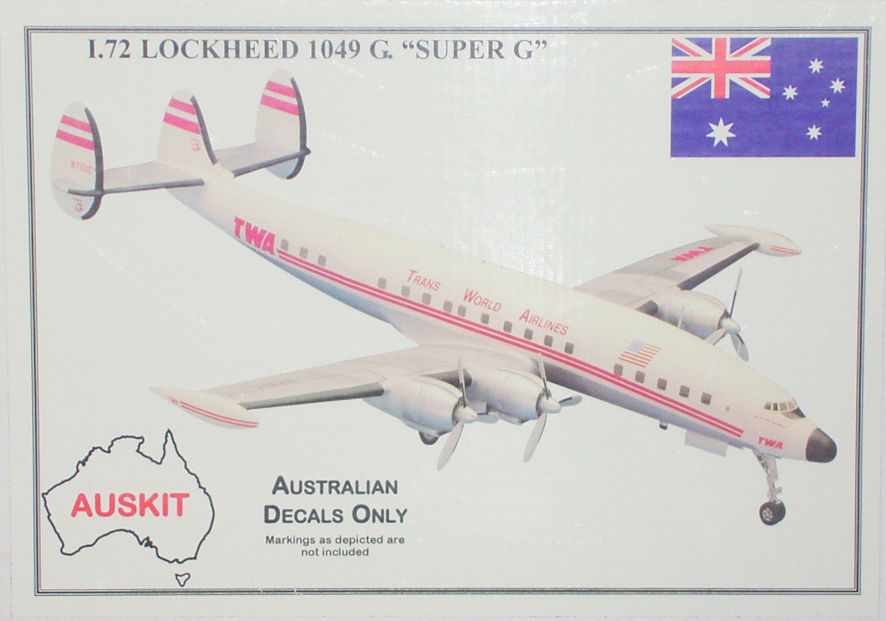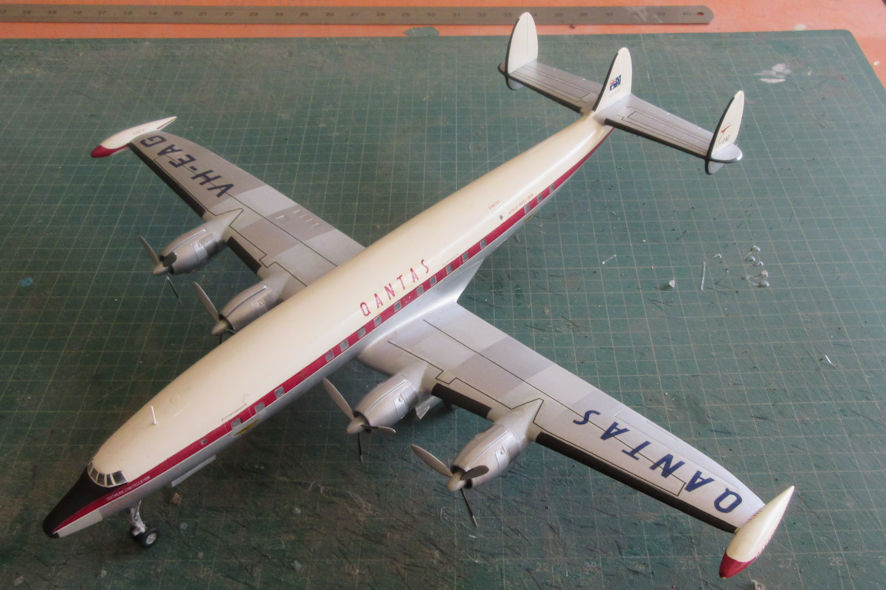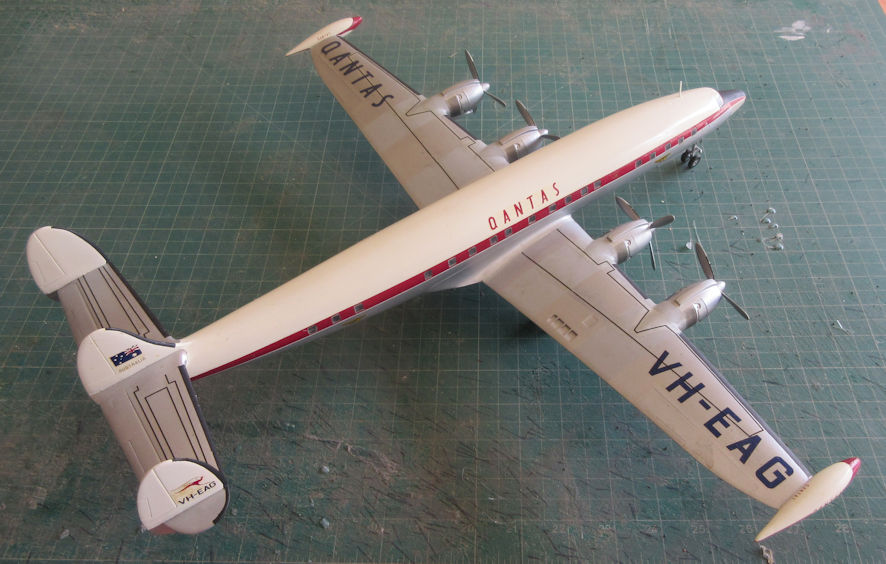Design of the Lockheed Constellation began in 1939 with orders placed by two United States airlines for a 40 seat airliner to fly on domestic routes. However, by 9 January 1943 when the first Constellation made its maiden flight, they were needed as military transports and taken over by the USAAF. Twenty two had been delivered by the end of the war when production was immediately turned back to civil production.
The first civil Constellation was certified for service in December 1943. Many early civil Constellations were military airframes fitted with full cabins, the first fully civil version, the L.649 with a capacity of 48 to 60 passengers, entered service in 1946 and a long range version, the L.749, was introduced to service the following year.
The Constellation enjoyed a fine reputation so development to improve its performance was the logical next step. The L.1049 Super Constellation had over 550 improvements, most important being a fuselage stretched by 5.59m (18 ft 2 inches), more powerful engines and greater range. For passengers the most attractive change was the replacement of porthole windows with rectangular ones that improved visibility by 85 per cent.
The first Super Constellation improved through a number of stages from the L.1049 to the L.1949H but perhaps the most successful was the L.1049G that had wing-tip tanks to extend its range beyond 4000 miles. However, piston engines were beginning to reach the limits of their potential and their powerful but complex engines began to make Super Constellations unreliable.
The ultimate version was the L.1649, with a new laminar flow wing and generally improved performance, but the first one flew in October 1956 when jet engines were beginning to enter civil service, and only a few were produced. Overall 857 Constellations and Super Constellations were manufactured.
Qantas became interested in Constellations immediately after the was and the first one entered service in October 1947. They were very successful so when the Super Constellation became available Qantas acquired them for its fleet.
Starting in April 1954 Super Consolations began operating on Qantas’s international routes and by the end of 1955 Qantas had twelve. In all Qantas flew eighteen Super Constellations but the introduction of Lockheed Electras and Boeing 707s at the end of the 1950s saw them withdrawn from service fairly rapidly so there were none left in service by May 1963.

For quite a few years this kit has been floating about, in a huge white box with an equally huge price tag. All it contained was the Heller Super Constellation kit and a sheet of Roodecals decals with Qantas markings. There should be a law against putting so little in such a big box but in the end the Super Constellation kit makes up into a rather large model. I paid about half the standard retail price and, at that cost, it was almost worthwhile.
Back in the ‘good old days’ before people invented the modern justice system, there used to be a thing called ‘trial by ordeal’. If you were accused of something the truth of the charge could be tested by putting you through an ordeal. For example, if the King had your foot put into a boot filled with molten lead and if it came out unharmed, you were obviously innocent. I thought this kind of thing had gone out with the Enlightenment, but then I discovered the Heller Super Constellation kit. I don’t know what crime I committed or whether I was found guilty or not. Either way, putting this kit together was an ordeal.
Let me just run through some of the most obvious problems with this kit. One of the most fundamental is very soft plastic this kit is moulded in, so when it came time to open up the air intakes in the engine nacelles it was almost impossible to get the plastic to hold a sharp edge. The same went for thinning trailing edges and tidying up joints. It may also have been the soft plastic that resulted in some spectacular warping, particularly the wings and tail. The only solution was the old trick of pouring boiling hot water on the plastic to make it pliable, the result was better but still not petty. Coming to the end of the project, when I finally put the wheels on the undercarriage legs three gave way under the weight of the model. (I didn’t put too much weight up at the nose.) I’ve never had that happen before!
Then there were problems with what might be termed accuracy. Part of his might be due to the fact that many of the parts are also common to the Heller Constellation kit so, for example, the cockpit shape is for the Constellation rather then the Super Constellation. The same may go for the engine nacelles that could be anything up to a quarter of an inch short with some bumps that don’t seem to be on the Super Constellation. To make up for that, the propellor spinners are something like 4 millimeters too long. Another challenge with the nacelles is that the lower air intakes are flat rather than curved. (This may have been done to simplify the moulding, but that is an unsatisfactory solution to save a little cost.) Talking of the moulding, there are huge moulding lines for the de-icing boots, and a few other extravagances that have to be removed. I solved some of these problems by ignoring them, others led to several outbursts of strong language as I rectified them.
After dealing with all that, and more, the resisting the temptation to drop the whole thing in the bin on several occasions, then there was the business of painting it. Most airliners of this time went in for gloss white cabin tops and polished metal just about everywhere else. White is not such a problem, but polished metal is. One solution might have been ‘Bare Metal’, but it always looks too shiny in small scale and, besides, I’d already had enough grief with this model. Instead I tried some of the Alclad II polished aluminum. The result was a fairly good finish but not as shiny as Qantas Super Constellations were in real life. I polished the Alclad II as much as I dared, and it looks good in comparison to my previous efforts with this kind of finish, but it’s still far from perfect. Then time came to apply the decals. In general they fitted fairly well, but not perfectly.
At the end of the day there was still more that could have been done but I was glad to see the end of the thing. The end result doesn’t look too bad but I’m not sure if wouldn’t have been easier to put my foot into a boot of molten lead.


Leigh Edmonds
December 2005
